The Permanent Maxillary Premolars
Premolars are so named as they are situated anterior to the molars. These teeth are present only in the permanent dentition.
Table of Contents
There are a total of eight premolars, four each in the maxilla and the mandible and erupt posterior to the canines: two in the right and two in the left quadrant.
Premolars are also referred to as bicuspids, i.e. teeth with two cusps but variations in the number of cusps may be seen in the mandibular premolars.
Read And Learn More: Oral Anatomy Notes
Class Traits Of Premolars
- The maxillary premolars develop from four lobes just as the anterior teeth except the mandibular second premolar that develops from five lobes.
- The premolars have two cusps, i.e. one buccal and one lingual except the mandibular second premolar which has three cusps, i.e. one buccal and two lingual.
- Buccolingual measurement is greater than mesiodistal measurement.
- Broader contact areas are generally placed at approximately the same level.
- Buccal and lingual crest of curvatures are more occlusal than in the anterior teeth.
- Marginal ridges are placed higher on the mesial then the distal aspect except in the mandibular first premolar where the distal marginal ridge is placed higher than the mesial marginal ridge.
- All the premolars other than the maxillary first premolar have one root; the maxillary first premolar has two roots, one buccal and one lingual.
The Permanent Maxillary First Premolar
The maxillary first premolar has two cusps and two roots. The buccal cusp is generally longer than the lingual cusp by about 1 mm.
The crown of the first premolar is shorter than that of the maxillary canine and also the mesiodistal width.
The maxillary first premolar exhibits features common to the posterior teeth. Certain features that differentiate the posterior teeth from the anterior teeth are as follows:
- Shorter crown length cervico-occlusally compared to the anterior teeth
- Buccolingual measurement greater than mesiodistal measurement
- Broader contact areas placed at approximately the same level
- Marginal ridges are placed higher in the vertical plane in posterior teeth
- The curvature of the cervical line is less on the mesial and the distal aspect in the posteriors
The morphology of this tooth will be described from the buccal, lingual, mesial, distal and occlusal aspects. The nomenclature, chronology and measurement of the maxillary central incisor are given in Tables.
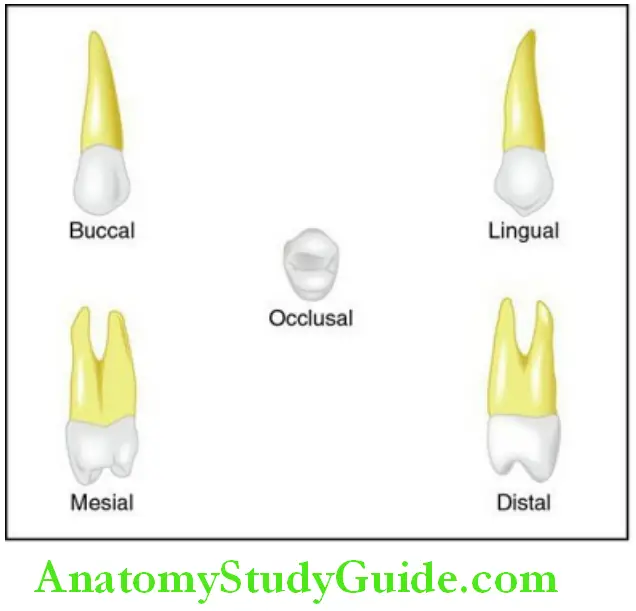
Nomenclature: Maxillary First Premolar:

Maxillary First Premolar: Chronology and Measurements:

Buccal aspect:
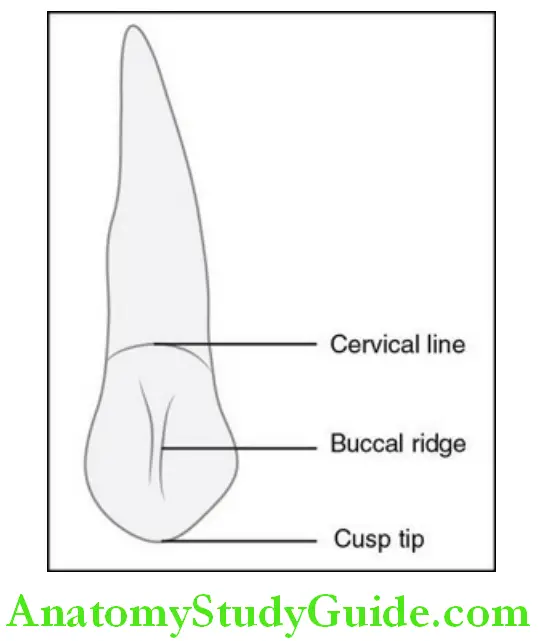
Features of the crown:
Shape and surface:
- Shape of the crown is roughly trapezoidal.
- The crown converges cervically and thus the mesiodistal dimension at the cervical line is approximately 2 mm less than the maximum mesiodistal dimension.
- The surface of the crown is convex.
- Buccal ridge is seen on the centre of the buccal surface that represents the well-developed middle buccal lobe.
- Developmental depressions are seen mesial and distal to the buccal ridge, which demarcate the middle buccal lobe from the mesiobuccal and the distobuccal lobes.
Mesial outline:
- The mesial outline is slightly concave from the cervical line to the mesial contact area.
- The mesial contact area is broad and located immediately occlusal to the middle of middle third.
Distal outline:
- The distal outline is straighter than the mesial outline from the cervical line to the distal contact area.
- The distal contact area is broader than the mesial contact area and is located a little occlusal to the mesial contact area.
Occlusal outline:
- The buccal cusp tip is the point where the mesial cusp slope meets the distal cusp slope.
- The mesial slope is straight and longer than the distal cusp slope.
- Distal slope of the buccal cusp is curved and short.
- The buccal cusp tip is distal to a line bisecting the buccal aspect of the crown.
- The cusp tip is pointed and is similar to that of the canine.
Cervical line:
- The cervical line is semicircular with the crest at the centre of the root buccally.
Features ofthe root:
- The root is shorter than that of the maxillary canine by 3–4 mm.
Lingual aspect:
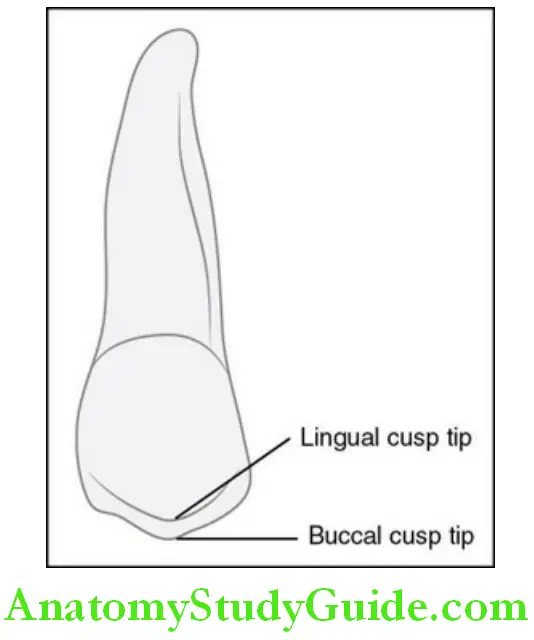
Features of the crown:
Shape and surface:
- The outline of the lingual aspect is the reverse of the buccal aspect.
- The crown tapers lingually as the lingual cusp is narrower esiodistally; thus, the mesial and distal surfaces of the crown are visible.
Lingual cusp:
- The lingual cusp tip is pointed as the mesial and distal slopes of the lingual cusp meet at 90°.
- From the cusp tip to the cervical region, the lingual cusp is smooth and spheroidal.
- A lingual ridge may be seen extending from the cusp tip to the cervical line.
- The lingual cusp is shorter than the buccal cusp and thus the tip of both the buccal and lingual cusps with their respective mesial and distal slopes are seen from the lingual aspect.
- The mesial and the distal slopes of the lingual cusp are continuous with the mesial and distal outlines which are convex; the outlines are then straight as they join the mesial and distal outlines of the root.
Features of the root:
- The lingual root or lingual portion of the root (in case of two roots) is convex and smooth.
- The root tapers along the entire length of the root. The apex is more blunt as compared to the buccal root.
Mesial aspect:

Features of the crown:
Shape and surface:
- The shape of the crown is roughly trapezoidal.
- The surface is convex except for the mesial developmental depression and the mesial marginal developmental groove.
- Mesial developmental depression:
- The mesial developmental depression is cervical to the mesial contact area and is on the centre of the mesial surface buccolingually and may often be continuous with the depression on the root and extend till the root bifurcation.
- It is bordered by the mesiobuccal and the mesiolingual line angles.
- Mesial marginal developmental groove:
- The mesial marginal developmental groove is a well-developed groove in the enamel, which is continuous with the central groove of the crown crosses the mesial marginal ridge lingual to the mesial contact area and terminates a little cervical to the mesial marginal ridge in alignment with the developmental depression on the root.
Buccal and lingual outline:
- The buccal outline is curved from the cervical outline to the crest of curvature; it is less convex from the crest of curvature to the cusp tip.
- The buccal crest of curvature is located at the junction of the cervical and middle third.
- The buccal cusp tip is in line with the centre of the buccal root.
- The lingual outline is smoothly curved from the cervical line to the lingual cusp tip.
- The lingual crest of curvature is located at the middle of the middle third.
- The lingual cusp tip is in line with the lingual outline of the root.
Occlusal outline:
- The buccal and lingual cusp tips are within the confines of the root trunk, i.e. the measurement between the buccal cusp tip and the lingual cusp tip is less than the buccolingual measurement of the crown.
- The lingual cusp is 1 mm shorter than the buccal cusp.
- The mesial marginal ridge is at the junction of the middle and the occlusal third.
Features of the root:
- The root trunk makes up half the root length and the bifurcation is for the rest half of the length of the root.
- The bifurcation is more occlusal on the mesial aspect than on the distal aspect.
- The two roots are the buccal and the lingual root.
- Buccal root: The buccal outline of the buccal root above the cervical line is straight with a tendency towards a lingual inclination.
- The buccal root may curve buccally at the middle third or maybe straight till the apical third.
- Lingual root: The lingual outline above the cervical line is straight but sometimes may be buccally or lingually inclined.
Distal aspect:

The distal aspect is similar to the mesial aspect with the following exceptions:
- The crown is convex with the exception of a small flat area cervical to the distal contact area.
- A flattened root trunk above the cervical line with no evidence of developmental signs may be seen.
- There is the absence of any developmental groove crossing the distal marginal ridge; if present is shallow and insignificant.
- Abrupt bifurcation of the roots near the apical third with no evidence of any developmental groove as seen mesially.
- Lesser curvature of the cervical line.
Occlusal aspect:
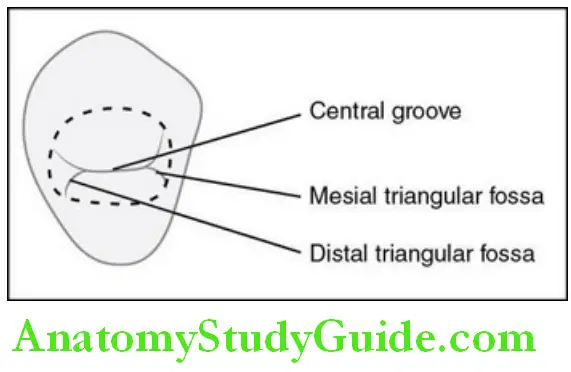
Outline and shape:
- The shape is a nonequilateral (six sides are not equal) six-sided hexagon with the six sides being the mesiobuccal, mesial, mesiolingual, distolingual, distal and distobuccal sides being the six sides.
- The distal side is longer than the mesial side.
- The distolingual side is longer than the mesiolingual side.
- The two buccal sides are almost equal.
Features of the crown on close observation:
- The crown is wider buccally than lingually.
- The buccolingual dimension is more than the mesiodistal dimension.
- More of the buccal surface is seen than the lingual surface when viewing the tooth from the occlusal aspect.
- The crest of the buccal ridge is distal to the crest of the lingual ridge.
- The crest of the distal contact area is buccal as compared to the mesial contact area which is lingual.
- The distance between the buccal crest to the mesial crest is longer than the distance between the buccal crest to the distal crest.
- The mesiobuccal outline is thus longer than the distobuccal outline.
- The distance from the distal crest to the lingual crest is longer than the distance from the mesial crest to the lingual crest, and thus, the distal outline becomes longer than the mesial outline.
Cusp ridges and marginal ridges: The cusp ridges and the marginal ridges circumscribe the occlusal surface.
- The distobuccal cusp ridge is buccal to the mesiobuccal cusp ridge.
- The angle between the mesial marginal ridge and the mesiobuccal cusp ridge is 90°
- The angle between the distal marginal ridge and the distobuccal cusp ridge is acute.
- The mesial and distal marginal ridges are continuous with the mesiolingual and distolingual cusp ridges through the lingual cusp in a semi-circular outline.
Developmental grooves:
- Central developmental groove:
- The central developmental groove is well-defined and located at the bottom of the central sulcus of the occlusal surface and divides the tooth buccolingually.
- It extends from a point just mesial to the distal marginal ridge to the mesial marginal ridge where it joins the mesial marginal developmental groove.
- Mesiobuccal and distobuccal developmental groove:
- These grooves join the central developmental groove just inside the mesial and distal marginal ridge.
- The point of the junction of the grooves is called the mesial and distal developmental pits.
Triangular fossa: They are two in number, namely the mesial and the distal triangular fossa.
- The mesial triangular fossa is distal to the mesial marginal ridge and the distal triangular fossa is mesial to the distal marginal ridge
Triangular ridges:
- The buccal triangular ridge is prominent and extends from the centre of the central groove and converges with the buccal cusp tip.
- The lingual triangular ridge extends from the centre of the central groove and converges with the lingual cusp tip but is less prominent.
- The features that can help in the identification of the maxillary first premolar are given in Box.
Features to identify the maxillary first premolar:
- Two cusps and two roots
- The buccal cusp is placed at a higher level than the lingual cusp
- Presence of the mesial marginal developmental groove
- Presence of the mesial marginal developmental depression
Differentiation Between The Right And Left Maxillary First Premolar
- The presence of the mesial marginal developmental groove and the mesial developmental depression
- The mesial slope of the buccal cusp is longer than the distal slope
- Distally placed buccal cusp tip
Development and landmarks Crown and root of the maxillary first premolar
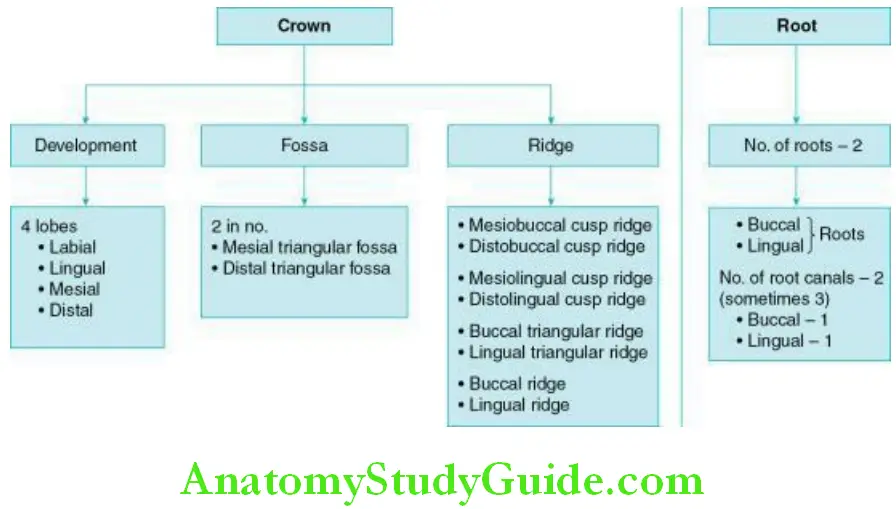
Variations And Developmental Anomalies
- Rarely the first premolar have a single root
- Dens evaginatus/Leong’s premolar
The Permanent Maxillary Premolars Synopsis
Labial aspect:
Crown:
- The shape of the crown is roughly trapezoidal.
- The crown converges cervically. The surface of the crown is convex.
- A buccal ridge is seen on the centre of the buccal surface.
- The mesial outline is slightly concave from the cervical line to the mesial contact area.
- The mesial contact area is broad and located immediately occlusal to the middle of the middle third.
- The distal outline is straighter than the mesial outline. The distal contact area is located a little occlusal to the mesial contact area.
- The buccal cusp tip is the point where the mesial cusp slope meets the distal cusp slope. The mesial slope is straight and longer than the distal slope.
- The buccal cusp tip is distal to a line bisecting the buccal aspect of the crown.
Root:
- The root is shorter than that of the maxillary canine by 3–4 mm.
Lingual aspect:
Crown:
- The crown tapers lingually as the lingual cusp is narrower mesiodistally.
- The lingual cusp tip is pointed as the mesial and distal slopes of the lingual cusp meet at 90°.
- From the cusp tip to the cervical region, the lingual cusp is smooth and spheroidal.
- A lingual ridge may be seen extending from the cusp tip to the cervical line.
- The lingual cusp is shorter than the buccal cusp.
Root:
- The lingual root is convex and smooth.
Mesial aspect:
Crown:
- The shape of the crown is roughly trapezoidal.
- The surface is convex except for the mesial developmental depression and the mesial marginal developmental groove.
- The mesial developmental depression is cervical to the mesial contact area and is on the centre of the mesial surface.
- The mesial marginal developmental groove is a well-developed groove in the enamel and is continuous with the central groove of the crown.
- The buccal outline is curved from the cervical outline to the crest of the curvature.
- The buccal crest of curvature is located at the junction of the cervical and middle third.
- The buccal cusp tip is in line with the centre of the buccal root.
- The lingual outline is smoothly curved from the cervical line to the lingual cusp tip.
- The lingual crest of curvature is located at the middle of the middle third.
- The lingual cusp tip is in line with the lingual outline of the root.
- The buccal and lingual cusp tips are within the confines of the root trunk.
- The lingual cusp is 1 mm shorter than the buccal cusp.
Root:
- The root trunk makes up half the root length and the bifurcation is for the rest half of the length of the root.
Distal aspect:
The distal aspect is similar to the mesial aspect with the following exceptions:
- The crown is convex at all points with the exception of a small flat area cervical to the distal contact area.
- Flattened root trunk above the cervical line with no evidence of developmental signs.
- There is the absence of any developmental groove crossing the distal marginal ridge; if present is shallow and insignificant.
- Abrupt bifurcation of the roots near the apical third with no evidence of any developmental groove as seen mesially.
- Lesser curvature of the cervical line.
Occlusal aspect:
- The shape is a nonequilateral (six sides are not equal) six-sided hexagon
- The distal side is longer than the distal side
- The distolingual side is longer than the mesiolingual side
- The crown is wider buccally then lingually
- The cusp ridges and the marginal ridges circumscribe the occlusal surface.
- The central developmental groove is well-defined and located at the bottom of the central sulcus of the occlusal surface and divides the tooth buccolingually.
- There are two triangular fossae namely the mesial and the distal triangular fossa.
The Maxillary Second Premolar
- The maxillary second premolar is present distal to the maxillary first premolar.
- This tooth resembles the maxillary first premolar in various aspects.
- The maxillary second premolar is rounded and not as angular as the maxillary first premolar.
- The second premolar has a single root and the length of the root is more than that of the first premolar, but the rest of the tooth may have the same dimension.
- The morphology of this tooth will be described from the buccal, lingual, mesial, distal and occlusal aspects.
- The chronology and measurement of the maxillary central incisor are given in Table.

Using the different tooth numbering the maxillary first premolar can be represented as shown in Table.
Maxillary Second Premolar: Chronology and Measurements:
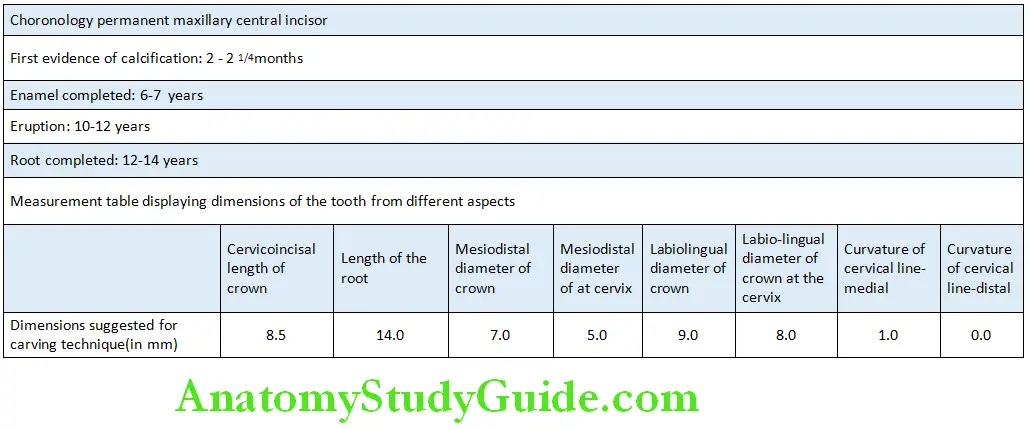
Nomenclature: Maxillary Second Premolar:

Buccal aspect:
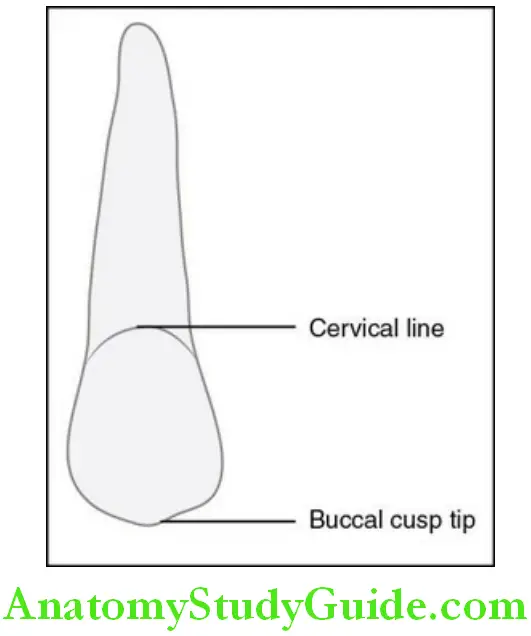
Features of the crown:
Shape and surface:
- The crown is less angular and more rounded. It may be thicker in the cervical region and thus the cervical convergence is less.
- The surface is convex due to the presence of the buccal ridge, but the buccal ridge is less prominent.
- The distal slope of the buccal cusp is longer than the mesial slope.
Mesial outline:
- The mesial outline is straight from the cervical line to the mesial contact area and then convexs to the cusp tip.
- The mesial contact area is located at the junction of the middle and the occlusal third.
Distal outline:
- The distal outline is more convex than the mesial outline.
- The distal contact area is located more cervical than the mesial contact area.
Occlusal outline:
- The buccal cusp has two slopes, the mesial and the distal cusp slope.
- The distal slope is longer than the mesial cusp slope.
- The two slopes meet at an obtuse angle.
Cervical line:
- The slight convexity is towards the root else the cervical line is straight.
Features of the root:
- The maxillary second premolar has a single root which is cone-shaped and tapering apically.
Lingual aspect:
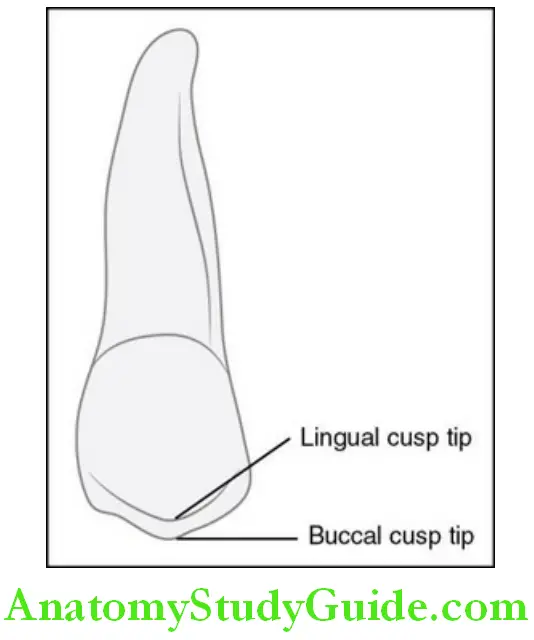
The lingual aspect is similar to the lingual aspect of the maxillary first premolar with the following variations:
- The lingual cusp is of the same length as the buccal cusp. Thus, the crown is longer on the lingual side.
- The lingual convergence is less than that of the maxillary first premolar.
Features of the root:
- The lingual root exhibits lingual convergence.
Mesial aspect:
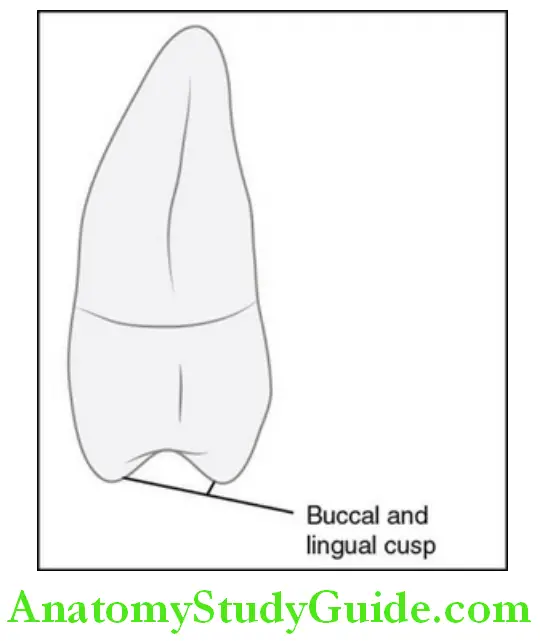
Features of the crown:
Shape and surface:
- The shape is similar to the first premolar.
- The surface of the crown is convex.
Buccal and lingual outline:
- The buccal outline is convex with the crest of curvature located in the cervical third of the crown.
- The lingual outline is more rounded with the crest of curvature located at the middle of the middle third.
Occlusal outline:
- The buccal and lingual cusps are nearly the same length but are shorter than the first premolar.
- The distance between the two cusp is more than the first premolar, and thus, the buccolingual dimension of the occlusal surface is greater.
- There are no developmental grooves on the mesial aspect of the maxillary second premolar.
Cervical line:
- The curvature of the cervical line is more on the mesial aspect than on the distal with the convexity towards the crown.
Features of the root:
- A shallow developmental depression is seen on the root which is single and tapered.
Distal aspect:

Features of the crown:
The crown on the distal aspect is similar to that of the mesial aspect with the following exceptions:
- The developmental depression is deeper.
- The distal marginal ridge is more cervically placed.
Occlusal aspect:
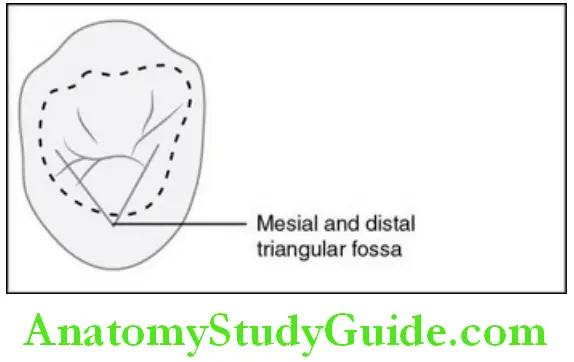
Features of the crown:
Shape and surface:
- In comparison to the first premolar
- The shape is less angular.
- The mesiobuccal and distobuccal line angles are less prominent and more rounded.
- The buccal ridge is less pronounced.
- The buccolingual dimension is more than the mesiodistal dimension.
- Lingual convergence is seen in the crown.
- The occlusal surface has a wrinkled appearance.
- The cusps, fossa, ridges and grooves of the maxillary second premolar are given in Table.
- The features that can help in the identification of the maxillary first premolar are given in Box.
Occlusal Surface of the Maxillary Second Premolar:

Features To Identify The Maxillary Second Premolar:
- Two cusps with the lingual cusp placed at the same height as the buccal
- Single root
- Rounded or less angular crown outline from the occlusal aspect
Differentiation Between The Right And Left Maxillary Second Premolar
- The distal slope of the buccal cusp is longer than the mesial slope.
- The root may have a distal tilt.
- Deeper developmental depression on the distal aspect of the root.
Development And Landmarks Crown And Root Of The Maxillary Second Premolar

Variations And Developmental Anomalies
- The tooth might vary in size in comparison to the first molar.
- Bifurcation of the root may be seen.
- Dens evaginates
The Permanent Maxillary Premolars Synosis
Labial aspect:
Crown:
- The crown is less angular and more rounded than the maxillary first premolar.
- The surface is convex due to the presence of the buccal ridge but the buccal ridge is less prominent.
- The mesial outline is straight from the cervical line to the mesial contact area and then convex to the cusp tip.
- The mesial contact area is located at the junction of the middle and the occlusal third.
- The distal outline is more convex than the mesial outline. The distal contact area is located more cervical than the mesial contact area.
- The buccal cusp has two slopes. The distal slope is longer than the mesial cusp slope The two slopes meet at an obtuse angle.
Root:
- The maxillary second premolar has a single root which is cone-shaped and tapering apically.
Lingual aspect:
Crown:
- The lingual aspect is similar to the lingual aspect of the maxillary first premolar with the following variations:
- The lingual cusp is of the same length as the buccal cusp. Thus, the crown is longer on the lingual side.
- The lingual convergence is less than that of the maxillary first premolar.
Root:
- The lingual root exhibits lingual convergence.
Mesial aspect:
Crown:
- The shape is trapezoidal and similar to the first premolar.
- The surface of the crown is convex.
- The buccal outline is convex with the crest of curvature located in the cervical third of the crown.
- The lingual outline is more rounded with the crest of curvature located at the middle of the middle third.
- The buccal and lingual cusps are nearly of the same length but are shorter than the first premolar.
Root:
- A shallow developmental depression is seen at the root. The root is single and tapered.
Distal aspect:
Crown:
- The crown on the distal aspect is similar to that of the mesial aspect with the following exceptions:
- The developmental depression is deeper.
- The distal marginal ridge is more cervically placed.
Occlusal aspect:
Crown:
- In comparison to the first premolar:
- The shape is less angular.
- The mesiobuccal and distobuccal line angles are less prominent and more rounded.
- The buccal ridge is less pronounced.
- Lingual convergence is seen in the crown.
- The occlusal surface has a wrinkled appearance.
Differences Between The Maxillary First And Second Premolar
Differences between the Maxillary First and Second Premolar:
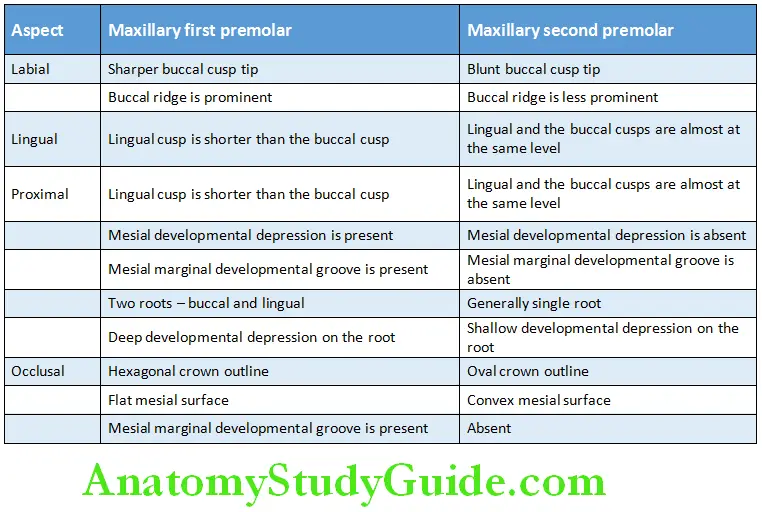
Leave a Reply